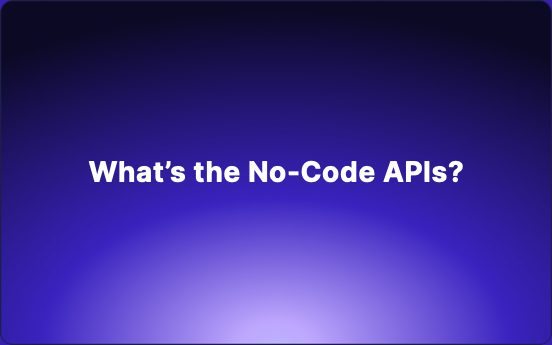What’s the No-Code APIs?
No-code APIs entail developers creating and handling APIs without the need to write code, utilizing API development tools to configure operations and establish connections with data sources.
No-code APIs signify a significant leap forward in software development, enabling the creation and upkeep of application programming interfaces without the need for conventional coding skills. These platforms offer user-friendly visual interfaces that empower users to define API endpoints, configure data models, and establish connections with diverse data sources.
By abstracting the intricacies of coding, no-code APIs democratize the process of API development, making it accessible to a wider range of individuals and organizations. This democratization speeds up development cycles, reduces costs, and fosters innovation, allowing businesses to rapidly create integrations and data exchange solutions.
No Code APIs - Future of API?
No-code APIs are tools that enable the creation and management of Application Programming Interfaces (APIs) without the need for coding. These platforms offer user-friendly interfaces with drag-and-drop components for building APIs, eliminating the complexity of using programming languages. This accessibility makes API development achievable for individuals without coding expertise.
Fundamentally, no-code APIs streamline the process of integrating various software applications and systems, facilitating data exchange and automation without requiring extensive technical knowledge.
Advantages of No-Code APIs
Increased Accessibility and Agility
Democratization of API Development: By removing the requirement for coding expertise, no-code APIs empower a wider audience, ranging from business analysts to marketers, to engage in API creation. This encourages a culture of innovation and experimentation.
Rapid Prototyping and Iteration: The intuitive interface and ready-made components of no-code platforms expedite the development process, enabling swift prototyping and testing of API concepts. This agility allows businesses to promptly adjust to evolving market dynamics and customer needs.
Enhanced Collaboration: No-code APIs promote collaboration between IT and business teams, enabling both groups to contribute to API development. This alignment of IT and business goals leads to more efficient and effective solutions.
Cost-efficiency and Resource Optimization
Reduced Development Costs: By eliminating the need for extensive developer resources, no-code APIs can significantly lower development expenses. This enables businesses to allocate their budget more strategically to other vital areas.
Optimized Resource Allocation: With no-code APIs, IT teams can concentrate on intricate, strategic projects while empowering business users to manage simpler API development tasks. This enhances resource utilization and boosts overall efficiency.
Improved Business Outcomes
Faster Time-to-Market: The expedited development process facilitated by no-code APIs empowers businesses to swiftly introduce new products and services, gaining a competitive edge.
Data-Driven Decision-Making: By facilitating seamless data integration and access, no-code APIs enable organizations to leverage data insights for informed decision-making.
Enhanced Customer Experience: No-code APIs can be utilized to craft personalized customer experiences by integrating data from various sources. This can result in heightened customer satisfaction and loyalty.
Risk Mitigation
Reduced Development Risks: The visual nature of no-code platforms and pre-built components can help reduce the risk of errors and bugs in the API development process.
Improved Security: Many no-code platforms offer built-in security features like authentication and authorization, enhancing the protection of sensitive data.
Creating No-Code APIs
To develop no-code APIs, developers simply need to locate a no-code API development platform. If you don't have one, we recommend considering Echoapi.

Building APIs with a Click
Once Echoapi is downloaded, you can initiate a new API creation process by selecting "New Request." The platform offers an easy-to-use interface for editing APIs. With a design-focused strategy and visual emphasis, Echoapi caters to developers of all levels of expertise.
As depicted in the image above, you can proceed by accessing the Params tab, where you can add query parameters to your API endpoint.
Testing No-Code APIs with Echoapi
Echoapi features a distinctive testing function known as test scenarios, enabling developers to test APIs without the necessity of writing code. It allows for sequential testing of multiple APIs to mimic real-world usage, particularly beneficial for interdependent APIs.
Echoapi Test Scenario Results
Upon completion of the test scenarios, Echoapi generates a detailed report outlining the outcomes, including the number of successful and failed requests, along with the total duration for all APIs to undergo testing.
Conclusion
No-code APIs have significantly reshaped the software development landscape. By reducing entry barriers and empowering individuals without coding skills, these platforms have democratized the creation of APIs. This has led to a surge in innovation, allowing businesses and individuals to quickly develop and deploy APIs to tackle various challenges. With the continuous evolution of technology, we can anticipate the emergence of more advanced no-code API platforms, further broadening opportunities for developers and businesses.
In summary, no-code APIs represent more than just a passing trend; they signify a fundamental change in how applications and systems communicate. As organizations strive to speed up digital transformation and enhance operational efficiency, embracing no-code APIs becomes crucial. By leveraging the capabilities of these platforms, businesses can unlock new revenue streams, enhance customer experiences, and gain a competitive advantage in today's dynamic market.




 EchoAPI for VS Code
EchoAPI for VS Code

 EchoAPI for IntelliJ IDEA
EchoAPI for IntelliJ IDEA

 EchoAPl-Interceptor
EchoAPl-Interceptor

 EchoAPl CLI
EchoAPl CLI
 EchoAPI Client
EchoAPI Client API Design
API Design
 API Debug
API Debug
 API Documentation
API Documentation
 Mock Server
Mock Server








